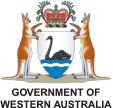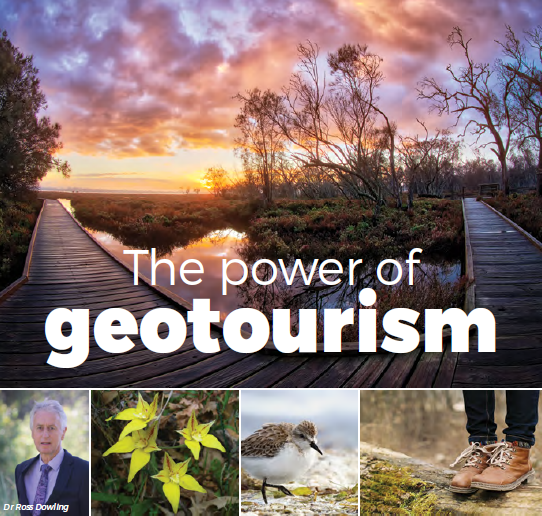In recent years there has been considerable interest in geotourism and geoparks. This is because both are drivers of successful, sustainable, regional development. Geotourism is a form of natural area tourism that specifically focuses on geology and landscape. It promotes tourism to geosites and the conservation of geo-diversity and an understanding of earth sciences through appreciation and learning. This is achieved through independent visits to geological features, use of geo-trails and view points, guided tours, geo-activities and patronage of geosite visitor centres.
And that means geotourism is taking place in natural environments like natural landscapes, wilderness and protected areas, but also in human modified environments like mine pits, road sections and urban settings, the Kalbarri Coastal Ecotrail is one such example.
Geotourism argues that to fully understand and appreciate the environment we must know about the Abiotic (non-living) elements of geology and climate first, as these determine the Biotic (living) elements of animals and plants. By extension, the combination of these components determine the Cultural landscape of how people have lived in the area in the past, as well as how they live there today. These are the key ‘ABC’ elements of geotourism, which is a new holistic approach to interpreting natural areas.
Geoparks are a program of the United Nations Education, Scientific and Cultural Organization (UNESCO), starting as a concept in 2004 and becoming a full UNESCO Program in 2015. Today there are hundreds of aspiring and national geoparks around the world, as well as 140 UNESCO Global Geoparks in 38 countries. As yet, there are no geoparks in Australia, however Western Australia’s diverse natural environment means the potential to develop geotourism as a vehicle for generating regional economic and social-cultural development is hig and there is already demonstrated interest from regional communities
Shires within the Murchison Region have been working for several years to create a GeoRegion and the Shire of Mt Magnet has taken the lead through its marketing brochure Mount Magnet – GeoHub of the Murchison. A number of workshops on Geotourism and Geoparks have been held in the region over the past few years, and steps are now being taken to ensure that the region’s attractions are marketed holistically through their ‘ABC’ elements so that a more complete story is shared about each of its tourism destination sites. In this way, the region can appeal to a greater number of tourist markets, each of which will leave the visitor with an increased appreciation of the region through the linking of the ‘ABC’ elements at all attraction sites.
The Western Australian tourism organisation, the Forum Advocating Cultural and Eco Tourism [FACET], pioneered geotourism when it hosted the Inaugural Global Geotourism Conference in 2008. This conference spawned others around the world and in May of this year, FACET hosted the Second International Workshop on Geotourism & Geoparks attracting 75 participants, illustrating the growing interest and momentum the concept of geotourism is gaining.
Geotourism is the economic driver of geoparks as it embraces all aspects of a region’s tourism destination sites and products. If geotourism is viewed as the ‘engine’ of regional development then geoparks are the ‘vehicles’. A geopark is an area of outstanding geology which fosters conservation, community growth and economic development. Their bottom-up approach for combining conservation with sustainable development while involving local communities is becoming increasingly popular around the world.
Geoparks encourage regional investment, create new businesses and jobs, and generate financial benefits to regional communities. In other parts of the world, geoparks now promote geotourism, geotours, geo-hotels, geo-restaurants and geo-cuisine etc. They have helped revitalise languages, arts and crafts, an interest in conservation and community goodwill. In the UK each UNESCO geopark adds approximately $4.82 million to the economy per annum whereas in Ireland the geoheritage and geotourism sector generates over $586 million per annum.
Geotourism and geoparks have enormous potential as vehicles to deliver sustainable benefits to regional Western Australia. Community interest in developing geo-regions and geotrails as the forerunner to geoparks will foster increased visitation to the regions and as such, will initiate product development, job generation and wealth creation over time. Peel’s natural environment, geological features and unique ecosystems make the emergence and growing popularity of geotourism an interesting consideration as a viable vehicle for expanding the region’s tourism market. Telling the story of the region through geotourism will allow visitors to more fully understand and appreciate its history and development in a way that sustains the region economically, conservationally and culturally.
Dr Ross Dowling OAM is Foundation Professor of Tourism at Edith Cowan University.
This article was first published in the Peel Magazine, Spring/Summer 2018 – vol 4.2 – to read and download the full magazine, click here.




